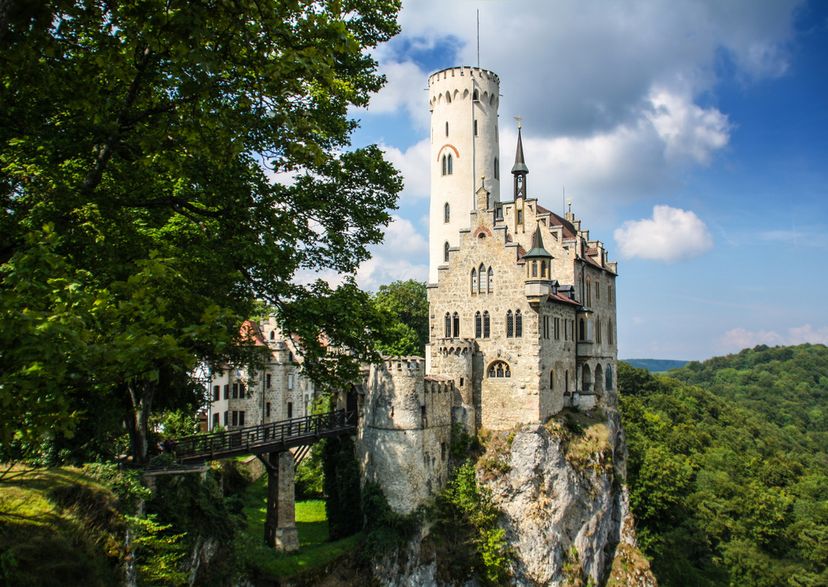
The Czech Republic is said to have more castles per square mile than any other country but by some estimates there are more than 20,000 Castles in Germany. It is hard to get an accurate number since the definition of a castle varies, however fortifications, residences, medieval and fairy tale castles dot the hills everywhere throughout the country. For the first time visitor it seems there is a Castle on every hilltop. Some of these structures date back hundreds of years. Today the Castles have been turned into hotels, museums and tourist attractions. Some have been purchased and remodeled as modern day homes and some still belong in the same family, having been passed down through the generations. Here are a few of the more noteworthy German Castles.
Advertisement
15. Reichsburg Cochem
Located in the scenic town of Cochem, Reichsburg Castle stands majestically overlooking the town. The Castle that stands today though is not the original one. Like many Castles in the old world, the current structure was built on the ruins of previous fortifications. The original structure dating from the 12th century was destroyed by the army of King Louis XIV in 1689. In 1868 wealthy Berlin businessman Louis Ravené bought the ruins and built the current Castle as a summer residence for his family. Some of the original structure such as the four story “witches tower” were incorporated into the new building. According to legend the witches tower was used a place to try women for witchcraft and if guilty they were thrown from the tower. Today the Castle is open to tourists and those that make the steep walk up the road from town are rewarded of breathtaking views of the town and Moselle Valley.
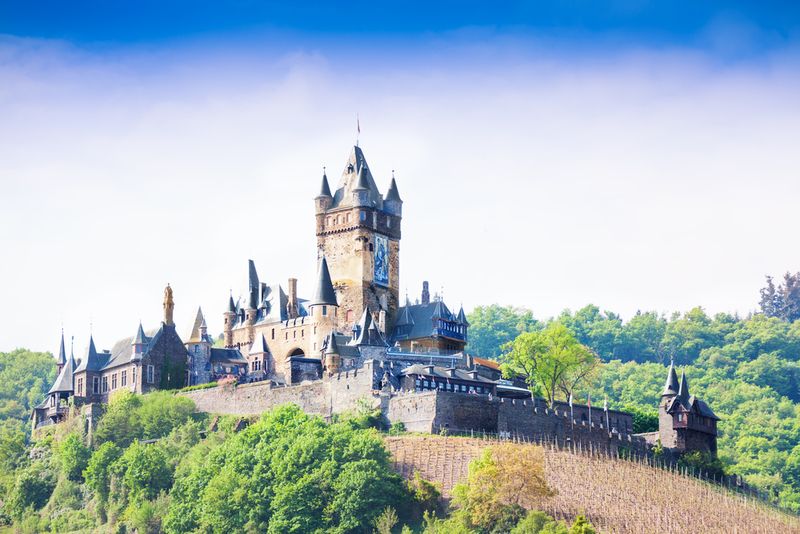
14. Schwerin Castle
Located on an island in the middle of Lake Schwerin lies the fairy tale Schwerin Castle. On the site of a former Slavonic fortress, dating from 973, Grand Duke Friedrich Franz II of Mecklenburg-Schwerin commissioned the building of the current Castle. Completed in 1857 the 653 room Castle contains valuable paintings, sculptures, gilded ceilings and intricate inlaid flooring. Visitors can view royal hunting and decorative weapon a porcelain collection from the royal porcelain manufacturer the ancestral gallery and enjoy the gardens which surround the Castle. The Grand Duke employed four of the most famous architects in Germany at the time to build the Castle and it stands today as one of the most beautiful in Germany. The castle contains 5 wings and is considered one of the best examples of European historicist architecture. The Castle is open to the public Tuesday through Sunday and guided tours are available.
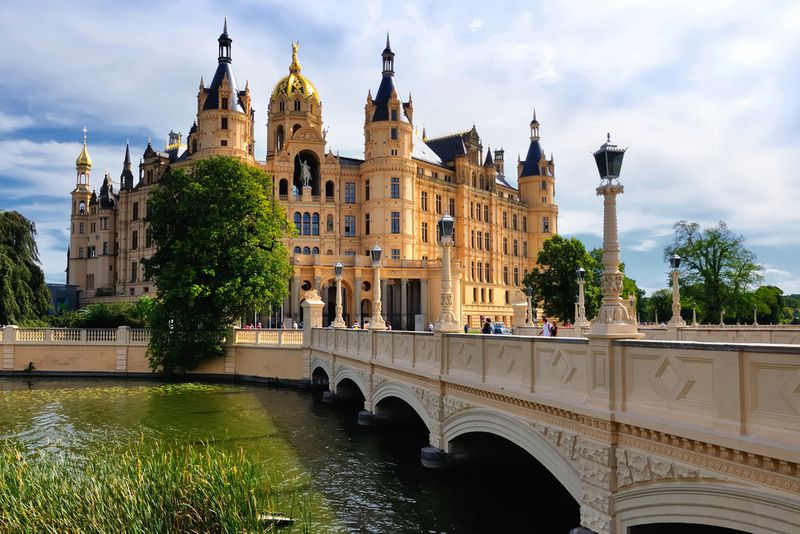
13. Linderhof Palace
King Ludwig Otto Friedrich Wilhelm, referred to as simply King Ludwig II, financed the building of a series of Castles. The only Castle Ludwig lived to see completed was Linderfof. Known as the royal villa, the Castle is an extension of his father’s, King Maximillian II, hunting lodge. In 1874 Ludwig took the lodge, Königshäuschen, had it dismantled and moved to the present location. The original wooden lodge was transformed by adding stone to the exterior along with adding a vestibule and staircase. The palace was transformed over the next four years to what exists today. Completed in 1878 the palace grounds contain a hidden grotto complete with a shell like boat on an underground lake lit with colorful lights. Ludwig built a hall of mirrors in the Castle along with two tapestry rooms. As is the case with a lot of German Castles, photography inside the Castle is not permitted.
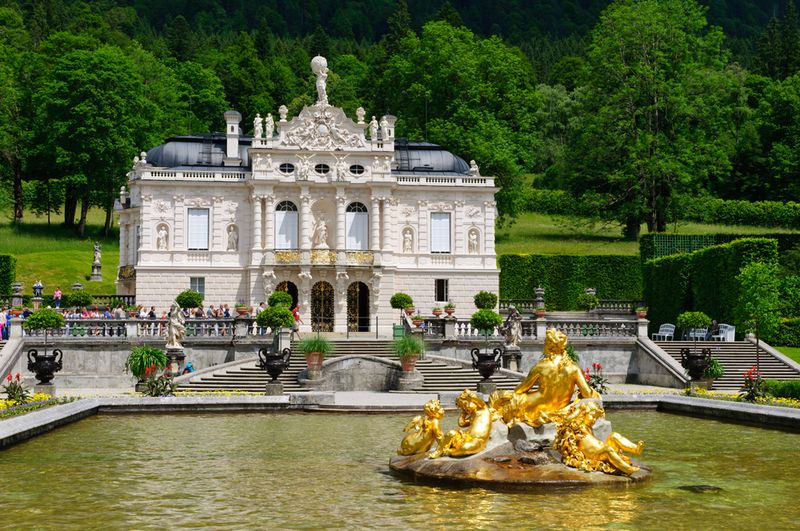
12. Wartburg Castle
Built in the middle ages in the year 1067, Wartburg Castle lies perched on a hill overlooking the town of Eisenach. Founded by Ludwig der Springer the Castle was further developed by the Ludovinger family that ruled the area for over 200 years. One of the more famous residents of the Castle was Martin Luther. After being excommunicated by the Pope, Luther sought refuge in the Castle and lived under protective custody. During this time Luther translated the New Testament from Greek into German. In 1922 Germany was proclaimed a Republic forcing the ruling German classes to abdicate and the Wartburg Foundation, which still exists today, was created to take over the responsibility of the Castle upkeep. Built with a mix of Romanesque, Gothic, Renaissance and Historicism styles the Castle contains a Great Hall constructed as living quarters for Thuringian counts. Artifacts from medieval times, world famous paintings and a cutlery collection from Baron Gottfried are included within the Castle.

Advertisement
11. Hohenzollern Castle
Hohenzollern is the ancestral seat of the Prussian Royal House as sits on a bluff above the towns of Hechingen and Bisingen in central Baden-Württemberg. The Castle is private property and still in the hands of the descendants of the Prussian and the Swabian family branch. Completed in 1867 by King Frederick William IV of Prussia, the Castle is a popular tourist destination and over 300,000 people visit each year. Some of the artifacts in the Castle include the crown of Prussian King Wilhelm II, personal effects of King Frederick the Great and a letter from President George Washington thanking Hohenzollern descendant Baron Von Steuben for his service during the American Revolutionary War. The magnificent Castle complete with chapels, royal chambers, royal treasury and gardens are open to the public where trained guides are on hand to revel you in the history.
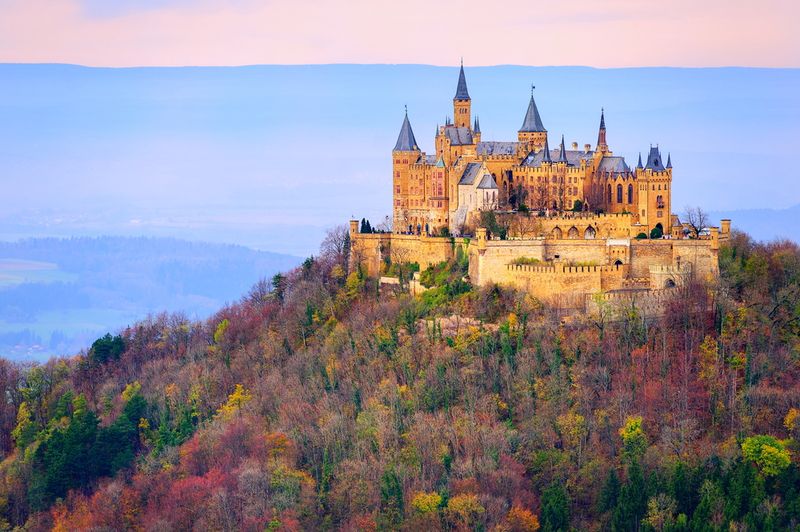
10. Imperial Castle of Nuremberg
During the medieval ages the Imperial Castle of Nuremberg was considered one the most important imperial castles of the Holy Roman Empire. The imperial chapel dating from 1200 is one of the oldest remaining parts of the castle. The site comprises three sections that being the imperial castle, municipal buildings of the imperial city and some remaining building of the Burgraviate of Nuremberg which was a state of the Holy Roman Empire. After the fall of the Holy Roman Empire in 1806 King Ludwig I of Bavaria began restoration of the castle as a place of residence. He soon abandoned the reconstruction however during the reign of son Maximillian a royal apartment was constructed. After the war of 1866 King Wilhelm I of Prussia gained the rights of the Castle from Ludwig II and stayed there on several occasions. In 1945, at the end of World War 2, much of the Castle was in ruins but the complex was rebuilt as before. The Castle is open to the public and visitors can learn about the history and reconstruction efforts that took place after the war.
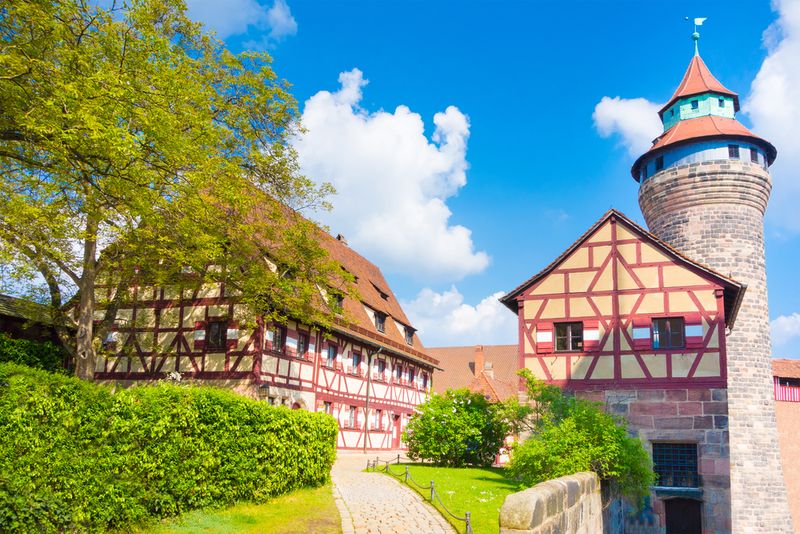
9. Burghausen Castle
With a history dating back to the Bronze Age, Burghausen Castle is the longest castle in Europe and one of the largest in the world. The current castle dates to 1025 but as early as 600 a large wooden fortification built by the Dukes of Bavaria occupied the area. In 1255 the castle became the second residence of the Dukes of Lower Bavaria and between the years 1392-1503 fortifications were extended around the entire hill. With a length of over 1,000 meters most of the castle’s medieval structures are still intact. The castle complex is divided into five courtyards, all originally protected by moats. The main castle is protected by a castle keep, towers and high walls and include a knight’s hall and dining hall with heating facilities. Today the castle contains two museums where visitors can learn about the history of the town and the House of Photography featuring photographs and cameras.
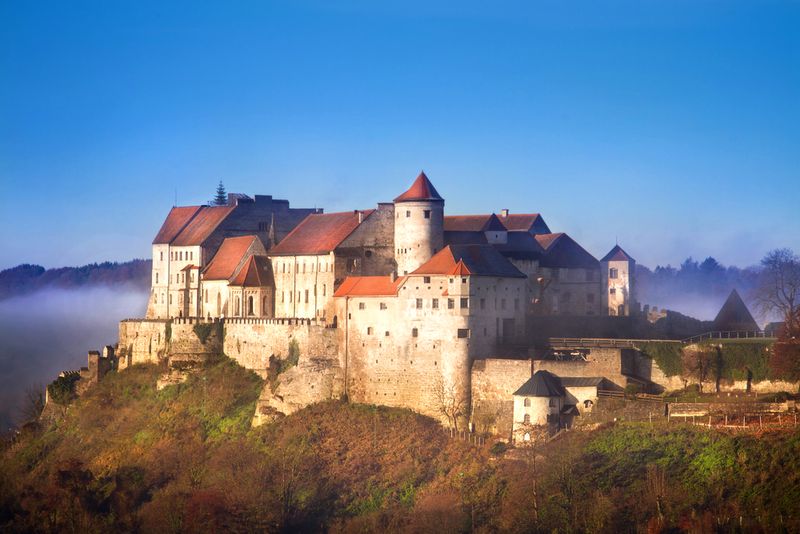
8. Eltz Castle
Located in the Mosul River Valley near the town of Koblenz sits the Eltz Castle. The Castle is one of the few that have never been damaged by war and is still intact. Surrounded on three sides by the Elzbach River, the Castle sits on rock 70 meters in height. The authentic medieval Castle dates to the 12th century and has been continually occupied by the same family. The current occupants are the 33rd generation of the Eltz family and live in two thirds of the Castle. The remaining one third of the Castle is open to the public. Many of the original furnishing from the past eight centuries are on display along with a treasury and armory that include world art works in gold and silver. Visitors over the years have included Emperors, Kings, Dukes and Duchesses. The poet Victor Hugo was a visitor and wrote about the Castle as well as German Presidents and the American First Ladies, Lady Bird Johnson and Rosalynn Carter.
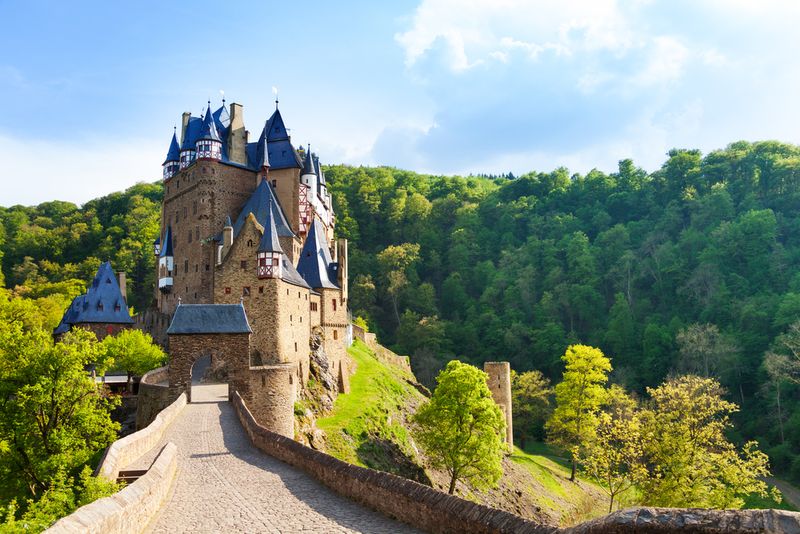
7. Marienberg Fortress
Founded by the Celts around 650 AD, the city of Wurzburg is the location of the Marienberg Fortress. The fortress is built on the site of the oldest church in Germany and the blue domed Marienkirche Church is the oldest part of the fortress. Originally built as defenses measures for the Celts the fortress was attacked by over 15,000 during the peasant wars but was never breached. During World War 2 the fortress was heavily damaged but through restoration efforts lasting until 1990 the structure was restored. Throughout history the Prince Bishops of Wurzburg utilized the fortress as a residence and today there are two museums located within the complex. The Mainfränkische Museum contains works of art including sculptures and other treasures. In the Prince’s wing the Fürstenbau Museum houses artifacts from the history of Wurzburg. The museum is open to the public from April to October every year.
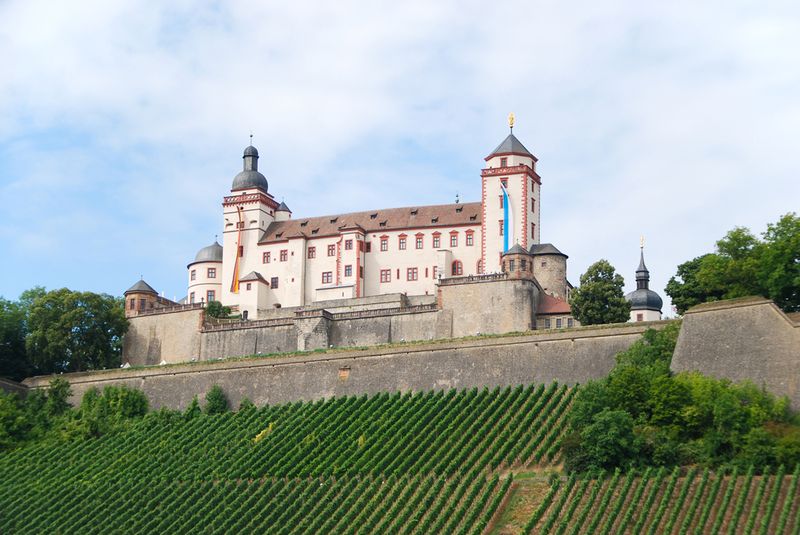
Advertisement
6. Wernigerode Castle
Originally a medieval fortress built to safeguard the Emperors on hunting expeditions the Wernigerode Castle dates from the 12th century. During the 16th century the Castle was rebuilt in the style of a Renaissance fortress. During the Thirty Years War the Castle was heavily damaged and rebuilt in the 17th century. As a result of the rebuilding efforts the current Castle is a mix of Neo Gothic, Renaissance, Baroque and Neo Romantic. The Castle contains two museum tours. One tour consists of 40 living rooms and bedrooms of European royalty and nobility and the other houses fixed exhibitions and special displays throughout the year. The Castle has been open to the public since 1930.
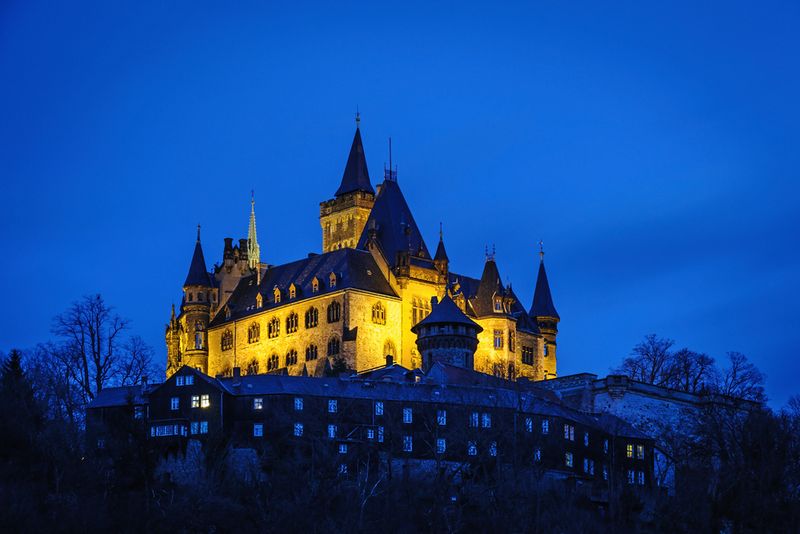
5. Lichtenstein Castle
At first glimpse, Lichtenstein Castle conjures up images of Dragons and Knights in shining armor storming out of the Castle on horseback to vanquish invading foes. The fortress built in 1390 withstood every attack. The Castle fell into disarray and was dismantled. The current Castle was built by Count Wilhelm of Württemberg. The Castle, a Neo-Gothic Knights Castle was inaugurated in 1842 with the King in presence. Located on a cliff near Honau in the Swabian Alps the Castle is reached by an elevated walkway. The Castle is still privately owned today by the Dukes of Urach but is open to the public. Known as “Württemberg´s fairytale Castle” visitors can stroll through the gardens, take a tour of the armory, visit the knight’s hall and visit the chapel with paintings dating from the 15th and 16th century. The chapel is often rented for weddings and the courtyard often hosts concerts.
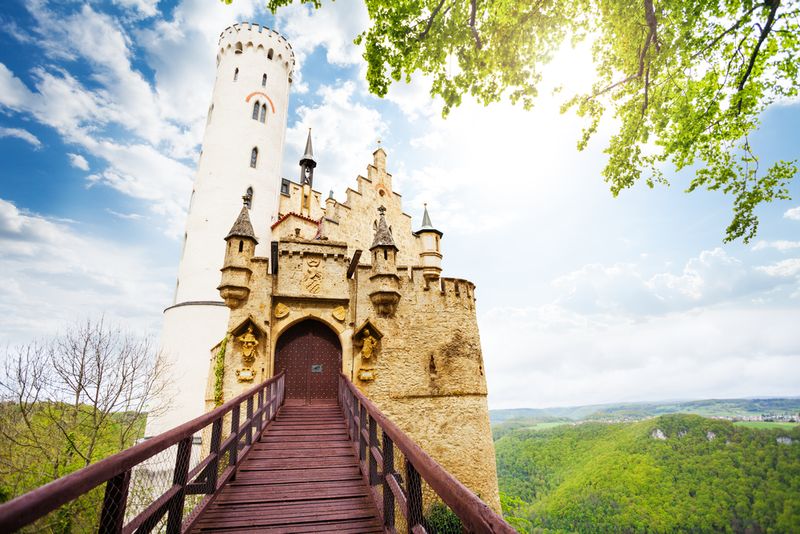
4. Albrechtsburg Castle
Albrechtsburg Castle is located in the town center of Meissen in the state of Saxony and sits on a hill above the Elbe River. The beginnings of the Castle were built in 929 by Germany’s first King, Heinrich I. Construction on the current Castle began in 1471. Built solely as a residence the Castle along with an adjacent cathedral are popular with tourists. The Castle, which is significant in Saxon history has been open to the public since 1881. World famous Meissen porcelain was manufactured at the Castle from 1710 until the manufacturer moved facilities in 1863 to the middle of town. The Castle showcases an exhibition of Meissen porcelain encompassing three centuries, including porcelain made for Catherine the Great of Russia and a centerpiece for King Augustus III. The Castle is open daily with the exception of December 24th and 25th.
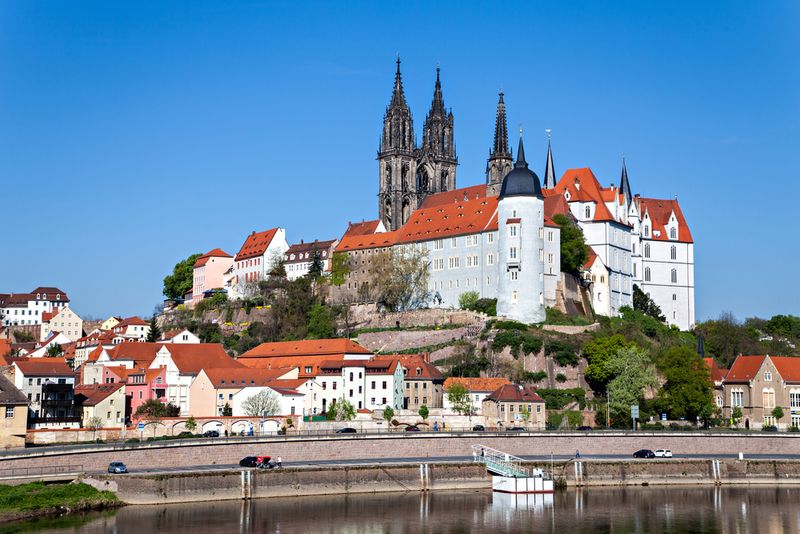
3. Babelsberg Castle
Babelsberg Castle looks as if it could be an English Manor Castle and with good reason. Built as a getaway palace for the future Emperor William I and his wife Augusta, the Castle was inspired by English Tudor buildings. The Castle and surrounding park are located in Potsdam, famous for the Potsdam Conference held at the end of World War 2. The Castle itself was the location of the talks between King William I of Prussia and Otto Von Bismarck that ended with the nomination of Bismarck as Minister President and Foreign Minister of Prussia. In 1990 the Castle became a UNESCO World Heritage Site. From the Castle you get a great view of Glienicke Bridge which separated the two sides during the cold war and was a typical prisoner exchange location.
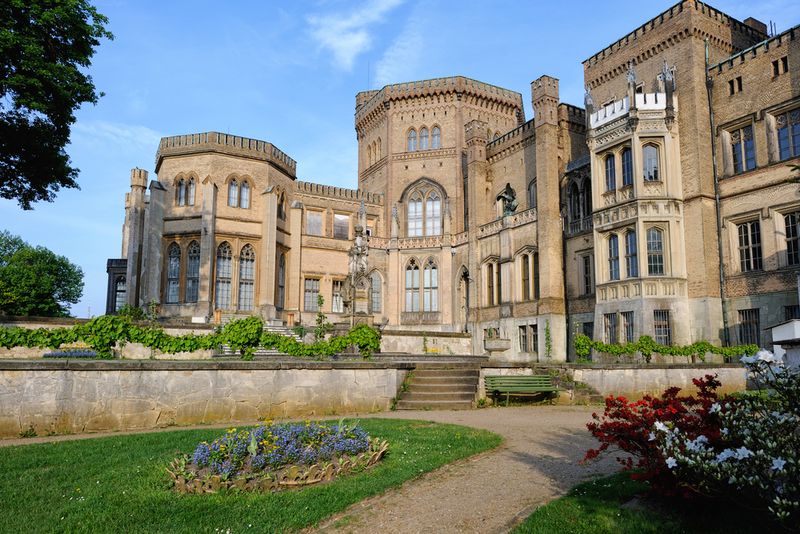
2. Frankenstein’s Castle
Frankenstein Castle is located near the German city of Darmstadt. Claims of the Castle being an inspiration of the famous Mary Shelley novel by the same name may or may not be true. What is certain is that the Castle is a famous draw for tourists. The Castle has been mentioned as early as 1252 however some believe it sits atop an older structure. Perched above the Rhine Valley the Castle does not have any museum or galleries. You can still see remains of the old draw bridge and walk the ramparts. Although Shelley’s novel doesn’t mention the Castle, she did visit the area in 1814 prior to writing her novel. Others speculate that John Konrad Dipple was the inspiration for the mad doctor. Dippel was born in 1673 inside the Castle and studied Science, Theology and Mysticism. Although he made some worthy contributions to science he also experimented with transference of souls using dead animals and by some accounts graduated to exhuming the bodies of recently deceased people in an attempt to resurrect them. Every Halloween an annual festival is held on the grounds.

Advertisement
1. Neuschwanstein Castle
Neuschwanstein Castle is not only Germany’s most famous Castle it is probably the most recognized Castle in the world. Built by King Ludwig II of Bavaria it was part of a series of Castles and was built as a place to get away from the tedious task of being King. Construction f the Castle began in 1868. Perched on a cliff, several meters of stone outcrop had to be removed and then an access road needed to be built. It was nearly a year before the first foundation stone was laid. The Castle contains an indoor grotto with artificial rocks and flowing waterfalls and walls adorned with murals depicting heroes and legends from Wagner’s operas. Disney has said they used Neuschwanstein as inspiration for Cinderella’s Castle. As ornate as the Castle is, it was never fully finished. Of the 200 plus rooms planned for construction only 14 were finished. Visitors to the Castle tour the bottom floors but the upper floors are closed because they are just bare rooms.
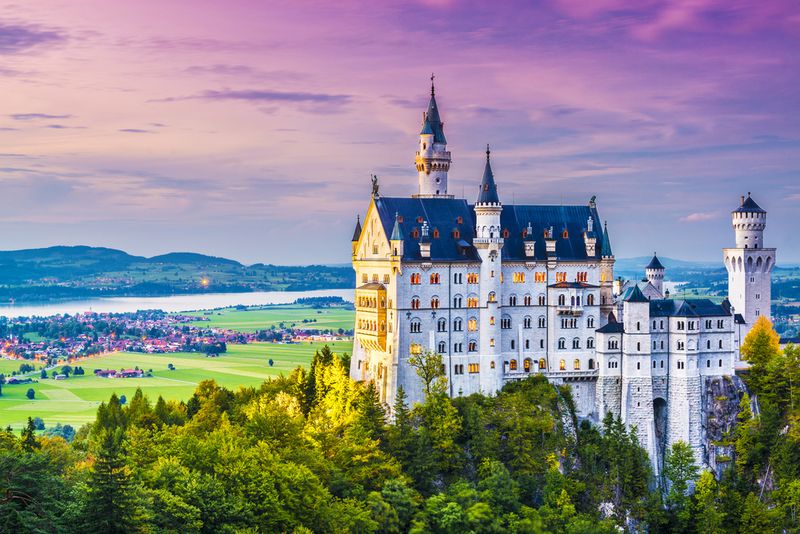
Advertisement